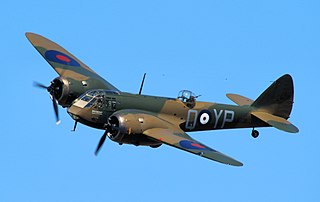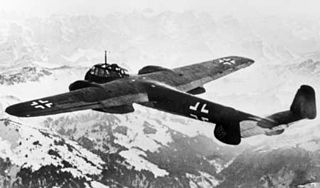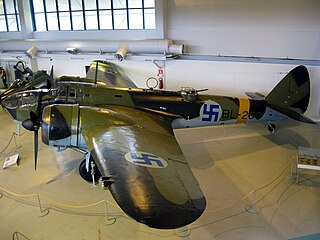Related Research Articles

The Bristol Blenheim is a British light bomber designed and built by the Bristol Aeroplane Company, which was used extensively in the first two years of the Second World War, with examples still being used as trainers until the end of the war. Development began with the Type 142, a civil airliner, after a challenge from the newspaper proprietor Lord Rothermere to produce the fastest commercial aircraft in Europe. The Type 142 first flew in April 1935, and the Air Ministry, ordered a modified design as the Type 142M for the Royal Air Force (RAF) as a bomber.

The Dornier Do 215 was a light bomber, aerial reconnaissance aircraft and later a night fighter, produced by Dornier originally for export, but in the event most served in the Luftwaffe. Like its predecessor, the Dornier Do 17, it inherited the title "The Flying Pencil" because of its slim fuselage. The successor of the Do 215 was the Do 217.

The 55th Operations Group is a component of the 55th Wing, assigned to the United States Air Force Air Combat Command. The group is stationed at Offut Air Force Base, Nebraska.
Flying Regiment 4 was a bomber aircraft regiment of the Finnish Air Force. The regiment was formed on 1 January 1938 and was active during the Winter War, the Continuation War, and the Lapland War. During the Winter War, the unit flew 423 war missions, of which 22 were strategic and photo reconnaissance flights with its Bristol Blenheim Mk.Is. 18 aircraft and 21 crew members were lost.
No. 12 Squadron, renamed No. 12 Reconnaissance Squadron was a reconnaissance squadron of the Finnish Air Force during World War II. The squadron was part of Flying Regiment 1.

No. 24 Squadron, renamed No. 24 Fighter Squadron was a fighter squadron of the Finnish Air Force during World War II. The squadron was part of Flying Regiment 2.

No. 42 Squadron, renamed No. 42 Bomber Squadron was a long-range bomber squadron of the Finnish Air Force during World War II. It was established in 1940. The squadron participated in the Winter, Continuation and Lapland wars as part of Flying Regiment 4, and was the only regiment in the squadron that exclusively operated Bristol Blenheim bomber aircraft. The squadron was abolished in 1952.
No. 44 Squadron, renamed No. 44 Bomber Squadron, was a bomber squadron of the Finnish Air Force during World War II. The squadron was part of Flying Regiment 4.
No. 48 Squadron, renamed No. 48 Bomber Squadron was a bomber squadron of the Finnish Air Force during World War II. The squadron was part of Flying Regiment 4.
No. 30 Squadron, renamed No. 30 Fighter Squadron was a fighter squadron of the Finnish Air Force during World War II, which had been formed from the disbanded No. 10 Squadron. The No. 30 Sqn was part of Flying Regiment 5.
No. 34 Squadron, renamed No. 34 Fighter Squadron was a fighter squadron of the Finnish Air Force during World War II. The squadron was part of Flying Regiment 3.
No. 6 Squadron, renamed No. 6 Bomber Squadron was a maritime bomber squadron of the Finnish Air Force during World War II. The squadron was part of Flying Regiment 5.

The Air Force of the Independent State of Croatia, was the air force of the Independent State of Croatia (NDH), a puppet state established with the support of the Axis Powers on the territory of the Kingdom of Yugoslavia during World War II. The ZNDH was founded under German authority in April 1941, following the German-led Axis invasion of Yugoslavia.

The 307th Operations Group is an Air Reserve Component of the United States Air Force. It is assigned to the 307th Bomb Wing, Air Force Reserve Command, stationed at Barksdale Air Force Base, Louisiana.

Paul Semrau was a German Luftwaffe military aviator and wing commander during World War II. As a night fighter ace, he is credited with 46 aerial victories claimed in 350 combat missions. All of his victories were claimed over the Western Front against the Royal Air Force's (RAF) Bomber Command.

The 97th Operations Group is a United States Air Force unit assigned to the 97th Air Mobility Wing of Air Education and Training Command. It is stationed at Altus Air Force Base, Oklahoma.
Air warfare during World War II in Yugoslavia pitted the Yugoslav Air Force, both Royal and NOVJ, United States Army Air Force (USAAF), the Royal Air Force (RAF), including the Balkan Air Force, and Soviet Air Forces against the German Luftwaffe, the Italian Regia Aeronautica and the Air Force of the Independent State of Croatia. The latter provided the majority of the support for the ground operations against the Partisans. The Allied forces engaged in an extensive bombing campaign in an effort to weaken the Axis hold on the country.

Nils Edward Katajainen was a Finnish fighter pilot and a Mannerheim Cross Knight. He held the military rank of sergeant major. He flew 196 sorties and shot down 35 enemy aircraft.

Charles Patrick Green was a South African-born British Royal Air Force (RAF) fighter pilot during World War II who was credited with eleven confirmed kills and another three probable. Most of these were during night missions, including seven over a period of three nights in June 1943, actions for which he received numerous awards. Green was also a member of the British bobsleigh team in the mid-1930s, winning several medals including World Cup gold and Olympic bronze.
References
Bibliography
- Goss, Chris. Dornier 17: In Focus. Surrey, UK: Red Kite Books, 2005. ISBN 0-9546201-4-3.
- Keskinen, Kalevi and Kari Stenman. Suomen Ilmavoimien historia 2: Dornier Do 17Z, Junkers Ju 88A-4. Hobby-Kustannus Oy, 1999. ISBN 952-5334-01-5.
- Smith, J.R. The Do 17 and Do 215 (No. 164). London: Profile Publications, 1967.
- Shores, Christopher F. (1969). Finnish Air Force 1918–1968. Aircam Aviation Series. Vol. S2. Canterbury, UK: Osprey Publications. ISBN 0-85045-012-8.